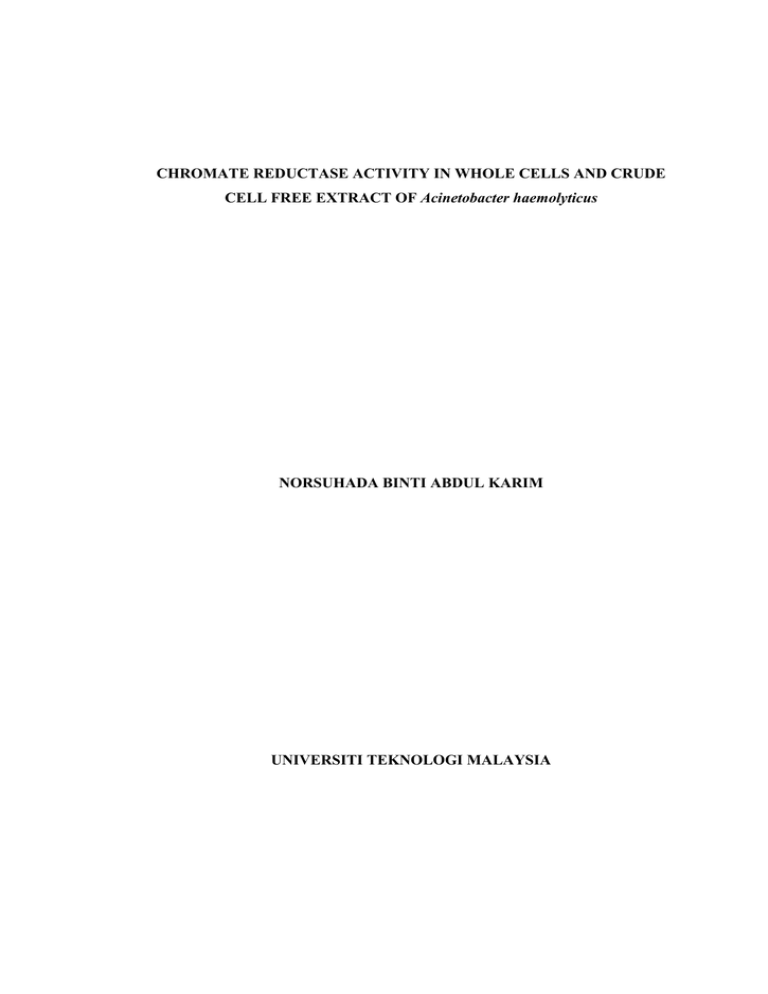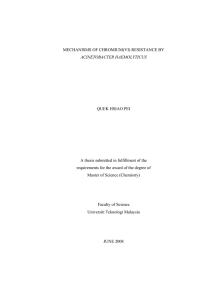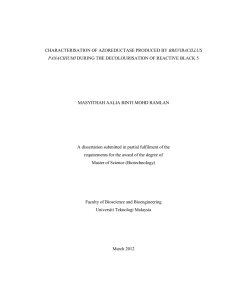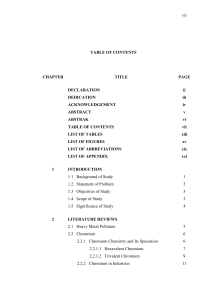CHROMATE REDUCTASE ACTIVITY IN WHOLE CELLS AND CRUDE Acinetobacter haemolyticus
advertisement

CHROMATE REDUCTASE ACTIVITY IN WHOLE CELLS AND CRUDE CELL FREE EXTRACT OF Acinetobacter haemolyticus NORSUHADA BINTI ABDUL KARIM UNIVERSITI TEKNOLOGI MALAYSIA i CHROMATE REDUCTASE ACTIVITY IN WHOLE CELLS AND CRUDE CELL FREE EXTRACT OF Acinetobacter haemolyticus NORSUHADA BINTI ABDUL KARIM A thesis submitted in fulfilment of the requirements for the award of the degree of Master of Science (Chemistry) Faculty of Science Universiti Teknologi Malaysia DECEMBER 2012 iii This thesis is dedicated to: Special dedication to my beloved father and mother, Abdul Karim bin Mohd Said and Jermiah bt. Haji Ariff, who have been with me every step of the way, through good time and bad. Thanks for all the tremendous love, prayer, guidance and support that you have always given me. For my beloved sisters and brothers, Faewati, Fauziah, Sulaiman and Muhammad Hafiz thanks for the continuous support, advices and motivation during the hard time…. Special thanks to my senior especially Nur Zulaikha Yusof who always keep my spirit in many moment of crisis, her encouragement and helping me to succeed and instilling in me the confidence to be a strong and capable person. and lastly For all my beloved friends especially Ainur Roshamizan, thanks for all your laughter, smiles, cries and joy. Your friendship and joy makes my life a wonderful experience. THANK YOU. iv ACKNOWLEDGEMENT Firstly, I am very grateful to Allah S.W.T for His Bless that I am finally finishing this report. A special note of thanks to my supervisor, Prof. Dr. Wan Azlina Ahmad, and co-supervisor, Dr. Zainul Akmar Zakaria for their helps during the course of this research. Without their time, expert opinion and patience much of this work could not have been accomplished. I have gained a lot of knowledge and experience during this research. I would like to acknowledge the Ministry of Higher Education (MOHE) for funding of the project (FRGS Vote No. 78532) and Ministry of Science, Technology and Innovation (MOSTI) for the National Science Fellowship (NSF) scholarship for funding my MSc programme in UTM for a period of two years. My sincere gratitude to staff of Department Chemistry, UTM and also to Mrs. Fatimah binti Harun from Bioscience and Bioengineering (FBB), UTM for assistance in cell preparation, Mr. Santhana Raj from the Electron Microscopy Unit, Institute for Medical Research, KL (IMR) for TEM analysis, Mr. Jefri bin Samin and Mr. Ayub bin Abu from Material Science Lab. Mechanical Engineering (FKM), UTM for FESEM–EDX analysis, Mrs. Nur Azleena binti Kasiran (IIS) for ESR analysis. I am also very thankful to all laboratory members (Ph.D and M.Sc students as well as contract staff) of the Biotechnology Laboratory for the cooperation and assistance during this project. Last but not least, I wish to express my sincere appreciation to my beloved family for their continuous support, advices and motivation for me to complete my research. Thank you so much. v ABSTRACT Extensive use of hexavalent chromium, (Cr(VI)) in various industrial applications is a threat to human health, living resources and ecological system due to its high solubility, toxicity and carcinogenic effects. Previously, one locally isolated Cr(VI) reducing-resistant bacteria, Acinetobacter haemolyticus was used in the ChromeBac™ system, to remove toxic Cr(VI) from industrial wastewater. However, this process required long retention time which was primarily due to the toxicity of Cr(VI) towards immobilized whole cells used. The use of enzymes can be a suitable option for the effective Cr(VI) reduction as compared to whole cells. In view of this, this study was conducted to assess in vitro characterization of the enzymatic chromate reductase activity in cell free-extract (CFE) for maximum activity of Cr(VI) reduction. Cr(VI) resistance and reduction of A. haemolyticus was evaluated in Luria-Bertani (LB) medium supplemented with various Cr(VI) concentrations. From the results, A. haemolyticus can resist up to 200 mg/L Cr(VI) in LB broth compared to 100 mg/L Cr(VI) in LB agar. The FTIR and FESEM-EDX analysis suggested Cr deposition onto the bacterial cells surface via complex formation between Cr species and either carboxyl, hydroxyl or amide groups. TEM analysis showed that Cr(III) is also distributed in membrane and cytosolic fractions of bacteria. ESR analysis revealed that chromium accumulated on bacterial surface and mostly as Cr(III). The enzyme activity was optimal at 30°C and pH 7 in the presence of 1 mM Co2+. The Michaelis-Menten constants, Km and maximum reaction rate, Vmax obtained from the Lineweaver-Burke plot were 184.47 µM and 33.3 nmol/min/mg protein in the presence of 1 mM Co2+. Optimum Cr(VI) reduction by immobilized CFE-alginate was determined at initial pH 3, 100 rpm and 5 g wet weight beads dosage. Although immobilized enzyme system was able to reduce Cr(VI), the performance was not as good as the free enzyme. This study showed higher Cr(VI) reduction performance by free CFE compared to the use of whole cells demonstrate its potential for industrial application. vi ABSTRAK Penggunaan kromium heksavalen (Cr(VI)) dalam pelbagai aplikasi perindustrian telah mengancam kesihatan manusia, sumber hidupan dan sistem ekologi disebabkan keterlarutannya dalam air, kesan toksik dan bersifat karsinogenik. Sejenis bakteria berdaya-tahan Cr(VI), Acinetobacter haemolyticus, telah digunakan dalam sistem ChromeBac™ untuk penyingkiran Cr(VI) daripada air sisa industri. Walau bagaimanapun, proses ini memerlukan masa yang lama untuk melengkapkan proses penurunan Cr(VI) menggunakan sel tersekat jerap disebabkan ketoksikan Cr(VI). Penggunaan enzim menjadi pilihan yang sesuai untuk penurunan Cr(VI) secara berkesan berbanding dengan sel lengkap. Oleh itu, kajian ini telah dijalankan untuk menilai pencirian enzim kromat reductase secara ‘in vitro’ dalam ekstrak sel bebas (CFE) untuk memaksimumkan aktiviti penurunan Cr(VI). Dalam kajian ini, A. haemolyticus telah dibiakkan dalam media Luria-Bertani (LB) yang ditambah dengan kepekatan Cr(VI) yang berbeza. A. haemolyticus telah didapati mempunyai daya-tahan sehingga 200 mg/L Cr(VI) dalam media LB berbanding dengan 100 mg/L Cr(VI) dalam media pepejal LB. Analisis FTIR dan FESEM-EDX telah menunjukkan pemendapan Cr pada permukaan sel-sel bakteria melalui kompleks antara spesies Cr melalui kumpulan karboksil, hidroksil atau amida. Analisis TEM menunjukkan bahawa Cr(III) juga disebarkan dalam membran dan pecahan sitosolik bakteria. Analisis ESR menunjukkan bahawa kromium yang terkumpul pada permukaan bakteria kebanyakannya adalah Cr(III). Aktiviti enzim adalah optimum pada suhu 30 °C dan pH 7 dengan kehadiran 1 mM Co2+. Pemalar Michaelis-Menten, Km dan had laju maksimum, Vmax diperolehi dari plot Lineweaver-Burk dengan nilai 184.47 μM dan 33.3 nmol/min/mg protein dalam kehadiran Co2+ (1 mM). Penurunan Cr(VI) oleh CFE tersekat gerak-alginat adalah optimum pada pH 3, kelajuan penggoncangan 100 rpm dan 5 g berat basah dos alginat. Walaupun sistem tersekat-gerak enzim dapat menurunkan Cr(VI) ke Cr(III), prestasinya tidak sebaik enzim bebas. Kajian ini menunjukkan prestasi penurunan Cr(VI) yang lebih tinggi dalam enzim bebas berbanding sel lengkap menunjukkan potensinya dalam kegunaan industri.



